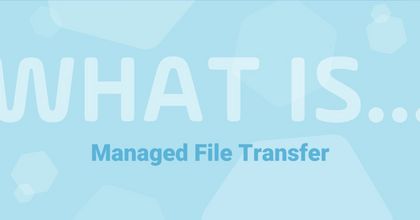What is Managed File Transfer?
Learn how to securely transfer data internally, with external third-party vendors, and across the boundaries of your hybrid IT environment.

Managed file transfer (MFT) is software designed to facilitate the secure transmission of data over a computer network. MFT has many benefits when compared to alternative ad-hoc file transfer solutions, such as FTP, SFTP, HTTP, or even email. Most often leveraged by enterprises, MFT software has the added benefits of security, encryption, automation, and observability.
The file transfer landscape has become multi-faceted. Historically, MFT was primarily concerned with transferring data via FTP to and from on-premises data centers. In today's hybrid IT environment, enterprises move data across a more complex landscape that includes:
- Internal on-premises-based applications (e.g., video file sent from desktop to desktop)
- External business partners, suppliers, or vendors (e.g., orders sent from a retailer to a manufacturer)
- On-premises and cloud-based applications (e.g., database sent from mainframe to AWS)
- Multi-cloud environments (e.g., database streamed from AWS to Azure)
Common Use-Case Scenarios for MFT
Enterprises use file sharing capabilities in different ways. To help bring managed file transfer to life, below are a few common use-case scenarios:
1. System-to-System Automated File Transfers
Automation and file transfer technologies are complementary. Technologies like workload automation (WLA) are used to design automated workflows that trigger events when files are transferred to or from a file folder.
For example, a company may receive a file from an external vendor, which is placed into an AWS S3 Bucket.
A workload automation solution constantly monitors the AWS S3 bucket. When a receive event is generated, it will immediately stream it to an Azure bucket for redundancy or staged for use by other cloud services. This simple workflow uses MFT between the company and the vendor, and then again between AWS and Azure. Workload automation is employed to orchestrate the automated jobs.
2. Human-to-Human Ad-Hoc File Transfers
In this scenario, the people (not the system) are required to initiate a file transfer. They will either send files through email or using a web interface.
Historically, this scenario has been an obvious way to create a security risk. However, with MFT in place, files are encrypted and sent securely. IT teams can control how files are transferred by their stakeholders. Plus, log data is created, which is visible on centralized dashboards. The dashboards can be made available to the IT team and the end-user.
Benefits of Managed File Transfer
Because of its powerful functionality — and its wide-ranging capabilities — a managed file transfer solution offers:
- Security and Governance: MFT eliminates the risk of insecure file exposure. There’s no need for time-consuming workarounds that may impact regulatory compliance. Additionally, centralized MFT administration helps the team enforce organizational IT policies.
- Observability and Auditability: MFT offers end-to-end visibility of all activity, so you know the who, what, where, and when of data transfers. Quickly access file-transfer logs and analytics to audit transfer activity whenever needed.
- Real-Time Data Transfer: Modern managed file transfer solutions use system events to automatically trigger data transfers, in addition to time-based task scheduling.
- MFT-as-a-Service: Empower employees to securely send files from email, web, and desktop applications — with zero disruption in workflow. Help your team get more done by automating data movement and enabling efficient data exchanges. Plus, eliminate the temptation to share sensitive information via unsecured methods.
- Connect to Any System and Partner: Use standard integrations or industry-standard file transfer protocols to share data. Additionally, B2B MFT offers enhanced perimeter security through authorized file transfers in the DMZ without any open inbound ports.
- Accessibility (for All): MFT offers a single, convenient solution for everyone in the organization. Secure web-based access ensures the right data is accessible to the right people at the right time.
MFT vs FTP
As mentioned above, the original file transfer protocol (FTP), and other unsecured services, are still commonly used despite their risks. When compared to FTP, a modern MFT solution provides the following advantages:
- Security: Unencrypted FTP tools, cloud-based sites, and USB drives are dangerous alternatives for enterprise data and file transfers. Worse yet, they exist entirely outside of corporate information governance policies. An MFT solution provides a high-performance platform to send and receive large files — safely and securely.
- Reporting and Administration: Modern MFT software offers comprehensive administrative capabilities for global visibility. Easily report on transfer status, errors, non-repudiation, user activity, system utilization, receipt monitoring, and routing.
- Advanced capabilities: MFT goes beyond FTP by:
- Smart-routing files based on policy or content
- Version management to prevent data duplication or data loss
- Connectivity between various operating environments
- Validate content and edit metadata
- Automation: FTP tools don't offer equivalent automation services to that found in MFT solutions. Most important is the automation that enables file or data transfers based on workflow rules and real-time events.
- Easy Integration: Today’s MFT solutions offer APIs that integrate with applications, middleware, email, and cloud platforms.
Must-Have MFT Features
Not all managed file transfer solutions are created equal. When looking at MFT vendors, you will want to make sure that their solution includes the following capabilities:
- Support for multiple file transfer protocols, including FTPS, SFTP, and HTTPS
- High-speed file transfers over public and private networks
- Secure file storage using multiple data encryption methods
- Centralized dashboard with real-time monitoring
- Non-Repudiation, or the ability to produce proof that the intended recipient received a file
- Integration with back-end applications and systems
- Support for all major platforms, including Windows and Linux, and cloud service providers
Summary:
Modern organizations hoping to keep up with the pace of digital transformation require the power of managed file transfer. Most enterprises will benefit from an MFT solution that's native, or tightly integrated with, a workload automation solution.
Next step: Learn how combining MFT and workload automation enables end-users to create truly next-level workflows.
Start Your Automation Initiative Now
Schedule a Live Demo with a Stonebranch Solution Expert






